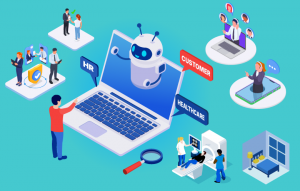“75% of professionals expect that generative AI will cause “significant or disruptive change in the nature of their industry’s competition” over the next three years, according to McKinsey’s research.”
It came with guns blazing. It stayed. It conquered. And it will change the way we see transformation. A little over a year ago, no one was discussing generative AI. And today, it found a sweet spot in everyday conversation among people. The dazzling debut of ChatGPT has made colossal changes. Ever since its inception, it has driven companies of all sizes to adopt and be in the market that is ever evolving.
The first moment you face the concept of AI solutions in your corporation will always initially look to be too much. However, if you divide the situation into small manageable portions the task can be made rather simple. Initially what is of utmost importance is not mere catchphrases but defining an experience vision. Describe the customer experience provision which will be used as the grounded idea and will lead to the conclusion of production or service generating.
1. Be comfortable with the change
Successfully integrating generative AI requires a change in culture, moreover, a shift in thinking. It demands a new set of beliefs where we let go of cynicism, fear, inflexibility, and competition so as to instead adopt the generative AI mindset, composed of curiosity, humility, adaptability, and collaboration.
Leading the AI users and the transformation is the art of cultivating AI mindset at the top of the organization to spread along the company. Therefore, you should have a culture in the organization where every member observes this and forever questions the current state (or the status quo), they also must be comfortable with change (and having failed), always need to experiment, and be willing to learn new things. It’s about a culture that is characterized by countless queries, such as, “How to give more value to customers?” or “How to build value for the world?” and last one, “How to use technology to realize that?”
2. Pay attention to your data needs
GenAI is data dependent. Hence, you should have a data plan if you don’t have one yet. Often, you will make progress, and it becomes natural to do things you wouldn’t be able to manage before. However, those skills will need occasional refreshing.
In terms of data to use when leveraging generative AI, focus on the data that is the most suitable in solving business issues and that will lead to the achievement of strategic goals. On the other hand, it’s imperative to see indent the shelf-life of that data as well. While it is interesting to know what kind of transactions or payments occurred in your business last week or a year ago, it is far more important to know what is happening in your business at this particular moment. While you are encouraged to think about AI strategy which enables you to retain and act on information you come across, it is best to do so ad as close as possible to the source.
“According to McKinsey, 40% of C-suite executives anticipate spending more on AI in the coming year.”
Moreover, you may classify internal and external data as the two primary data types so that data analysts can determine what data are more appropriate nor how to use them. Owning your data is kind of very precious, considering the fact that the data is probably the only kind of data that your organization has. While this may well be the case, the outside data (i.e. social media data) can, nevertheless, prove to be very accurate.

Why AI implementation projects fail and how you can avoid it
Let’s explore five reasons why organizations fail in implementing AI in business processes and how to tackle these challenges to ensure successful AI integration.
3. Generative AI is not a replacement for humans
We’ll start with the most popular myth surrounding GenAI. AI won’t do our jobs for us. We can use it effectively. The aim of applying such technology is to automate or streamline simple and routine tasks. Now, as a result of automating your mundane day-to-day operations, it gives you a chance. Generative AI cannot fully substitute the need for millions of people who are very talented and can perform creative, problem-solving and relationship-building – (but) there’s hope for improving the work for these humans.
4. Be strategic
The role of this AI application in generating business is very big. Therefore, you should check if your AI strategy remains relevant or not and if there’s any need for approval updates to use the generative AI advantages to the fullest. This translates to ending up at the point of you having to thoughtfully evaluate the possible consequences of generative AI for your current business set-up, the products or services that you offer on the market, and possibly even the overall business model that you are currently employing, and then update your entire business strategy in accordance therewith.
5. Focus on technology building blocks
There are three fundamental elements that will help you leverage generative AI successfully: first is fast, secure, and connectivity (not only at your offices but also on the go). Second is data infrastructure (i.e., the software and hardware used for collecting, storing, and accessing the data essential to your business). Third is cybersecurity, which involves using technologies to keep away malware, phishing, and other kinds of threats.
Then, the generative AI tools that straddle the foundation roost on them. Rather, you’d be using a ready-made interface such as ChatGPT or its base GPT-4 language model, having to evaluate the privacy risks involved beforehand. (For instance, put yourself in the place of whether or not you want your data to be used for training language models or even if other users will be able to see your data.)
Generative AI: Business use case
 |
Text generation: Generative AI performs text generation, creating individualized messages, designing websites, social networks, or email content perfectly, and customizing written text depending upon different needs. |
 |
Image generation: AI is turning out to be useful in fields such as design, marketing, and gaming apparently thanks to its ability to materialize images out of simple text description. It serves the task of training, architectural visualizations as well as many other things. |
 |
Video synthesis: The 21st century visual age needs a technology like generative AI, that fastens video production, thus helping augmented reality (AR) and advertising as well. Extensive manual editing is reduced. |
 |
Knowledge management: Through generative AI, it is possible to categorize and analyze large datasets, making it simpler to detect the trends and common themes used in making informed decisions and targeting strategies capable of solving a specific problem. |
 |
Language translation: Generative AI allows for on-the-spot language translation, the advantage of which can’t be underestimated for anyone whose position requires customer service. This will likely promote translation quality and availability further. |
 |
Developer experience: Generative AI performs a dual role as both an AI assistant and an information hub for developers that contribute to the development task with useful and well-structured information. |
Generative AI is still in its early stages, but its potential seems limitless. As this technology continues to evolve, we can expect to see even more innovative applications emerge across various industries. Generative AI has the potential to revolutionize the way we work, live, and interact with the world around us. It’s an exciting time to be alive and witness the possibilities that generative AI deciphers. Having said that, we are one of the early adopters and deliver generative AI consulting services according to your business needs. If you have something in mind, don’t hesitate to touch base with us.









